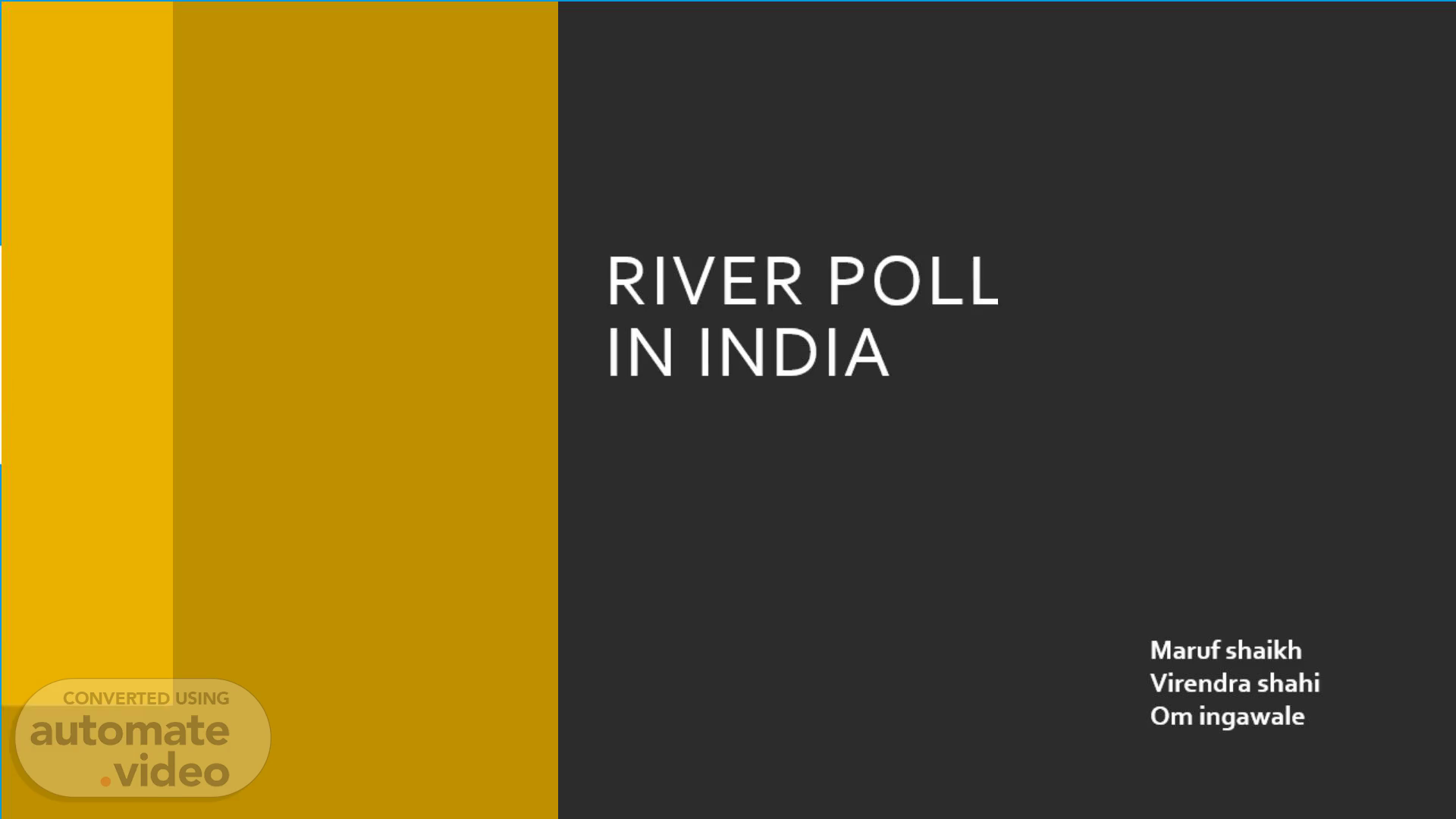Scene 1 (0s)
River Pollution in India. Maruf shaikh Virendra shahi Om ingawale.
Scene 2 (8s)
[Audio] Rivers of India India's rivers, including the Ganges, Yamuna, and Godavari, are vital lifelines for agriculture, drinking water, transportation, and cultural practices, but face severe pollution due to urbanization and industrialization. Significance of Rivers in India: Rivers serve as vital resources for agriculture, drinking water, transportation, and cultural activities.
Scene 4 (43s)
[Audio] What is river pollution Rivers across the country, especially near urban areas, face severe issues due to growing industrialization and urbanization, this leads to river pollution. River Pollution: Contamination of water bodies through harmful substances like industrial waste, sewage, chemicals, and agricultural runoff..
Scene 5 (1m 10s)
[Audio] Key pollutants of Indian River Untreated Sewage: we generate a large amount of untreated sewage, which is discharged directly into the river due to inadequate Sewage treatment infrastructure in the region. Industrial Waste: Several small and medium-scale industries near the river which contains toxic chemicals, heavy metals, and dyes contribute to chemical contamination. Agricultural Runoff: The use of fertilizers and pesticides in surrounding farmlands leads to runoff into the river, affecting water quality. Solid Waste and Plastic Pollution: Non-biodegradable waste such as plastic bottles, wrappers, and bags are dumped into the river by both local residents and industries. Religious and Cultural Practices: Immersion of idols and religious offerings during festivals like Ganesh Chaturthi adds to the pollution..
Scene 6 (2m 5s)
A group of people cleaning up trash in a river Description automatically generated.
Scene 7 (2m 13s)
[Audio] Challenges of Managing River Pollution Inadequate Sewage Treatment Infrastructure leading to untreated sewage being released into the river. Lack of Industrial Waste Management & continuation to discharge untreated effluents into the river without proper treatment. Unregulated Disposal of Solid Waste accompanied with Limited public awareness on waste segregation and disposal leads to rampant plastic and garbage dumping into the river. Overexploitation of River Resources by extraction of river water for industrial and agricultural use further exacerbates pollution and depletes the river..
Scene 8 (2m 54s)
A river with garbage in it Description automatically generated.
Scene 9 (3m 1s)
[Audio] Health Hazards Waterborne diseases like cholera, diarrhea, and typhoid affect millions due to sewage contamination. Toxic chemicals like arsenic, mercury, and lead from industrial waste pose long-term health risks. *20 million people are affected by arsenic contamination in the Ganges (ICMR)*.
Scene 10 (3m 22s)
A river flowing through a city Description automatically generated.
Scene 11 (3m 29s)
[Audio] Ecosystem Damage Eutrophication from untreated sewage reduces oxygen levels, degrading ecosystems. Fish and Aquatic life endangered Due to water Pollution more than 80% of fish species in the Ganges have disappeared..
Scene 12 (3m 45s)
A diagram of a diagram Description automatically generated.
Scene 13 (3m 52s)
[Audio] Economic Loss Loss of Fisheries: 40% of fishermen in Varanasi lost their livelihoods due to declining fish stocks. Agriculture: 15-20% reduction in crop yield due to polluted irrigation water from rivers like the Ganges and Yamuna. Tourism: Tourism revenue in Varanasi dropped by 15% due to river pollution concerns..
Scene 14 (4m 19s)
A body of water with boats and trash on it Description automatically generated.
Scene 15 (4m 26s)
[Audio] Government initiatives National River Conservation Plan (NRCP) Initiated by the government of India to address pollution in major rivers. Focuses on setting up sewage treatment plants and improving water quality monitoring. Swachh Bharat Mission (Clean India Mission) Encourages cleanliness and waste management to prevent river contamination. Promotes community participation in waste segregation and cleanliness drives..
Scene 16 (4m 56s)
A group of people in a river Description automatically generated.
Scene 17 (5m 3s)
[Audio] NGO's and community NGOs Involved: Local organizations like "Mula-Mutha River Cleanup" are actively engaged in river restoration activities. Awareness campaigns on reducing pollution and promoting responsible disposal practices. Community Participation: Public participation in clean-up drives and eco-friendly religious practices (idol immersion with eco-friendly materials). Engaging local residents and businesses in river conservation efforts..
Scene 18 (5m 34s)
[Audio] Conclusion River pollution in India is a pressing issue with significant health, environmental, and economic impacts. It is crucial for all stakeholders to work together for cleaner rivers with collective action and innovative solutions. "Save rivers, save life – clean rivers are the lifeblood of our planet.".
Scene 19 (5m 57s)
THANK YOU.
